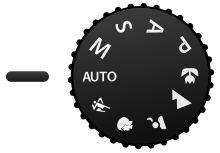Shutter priority

Shutter priority refers to a setting on some cameras that allows the user to choose a specific shutter speed while the camera adjusts the aperture to ensure correct exposure. This is different from manual mode, where the user must decide both values, aperture priority where the user picks an aperture with the camera selecting the shutter speed to match, or program mode where the camera selects both.
Shutter priority with longer exposures is chosen to create an impression of motion. For example, a waterfall will appear blurred and fuzzy. If the camera is panned with a moving subject, the background will appear blurred. When photographing sports or high-speed phenomena, shutter priority with short exposures can ensure that the motion is effectively frozen in the resulting image.
Like aperture priority, this mode allows for partial automation thus decreasing the need for total concentration. Shutter priority and aperture priority modes are favourable to street photographers as it allows them to control one important aspect that effects the style of the picture while allowing the camera to handle other less important settings.
Shutter priority is often abbreviated as S (with Nikon, Minolta, Konica Minolta, Sony, Olympus, Sigma) or Tv (for "time value" with Canon, Pentax, Leica) on a camera mode dial.
